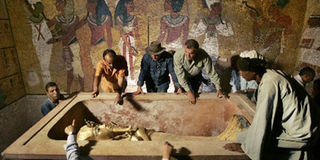Egypt, not Greece, inspired Western civilisation

PHOTO/ FILE
What you need to know:
- Evidence demonstrates that Ancient Egypt received material and cultural nourishment from the Nile and its people, who
progressed from deeper sources within the very womb of civilisation
Although we might not think of calling these fathers of Western thought Afro-centrist, Herodotus, Plato, Aristotle, and Hippocrates all acknowledged the debt owed by Greece to Egypt.
The assessment of Ancient Greece as an impromptu starting point of Western civilization therefore seems to contradict the awe held for Egypt by the Greeks, who borrowed heavily from Egyptian art, architecture, astronomy, mathematics, medicine and religion.
But from what source did Egypt derive its creative spirit? The Egyptians left hieroglyphic records revealing a personal belief to the effect that their forebears had followed the flow of the Nile from southern regions, and while retracing those steps southward along the White and Blue Niles a revealing phenomenon unfolds.
One virtually steps back in time to witness a continuation of living culture that has survived until this day. Layers of foreign interference dissolve, until Pre-dynastic Egyptian methods of agriculture, pottery, trappings of religious ceremony and even social fabric, are found to still be in some form of relative practice.
Immediately apparent are the various wooden farming tools still used in industry today, which are identical to those of Pre-dynastic Egyptians.
Egyptian furnishings and accoutrements such as the traditional African headrest and the long toothed hair comb also draw immediate comparisons with their Sub-Saharan counterparts.
Even the two omnipresent hand held symbols of Pharaoh’s authority, the hook and flail, transmute as the flywhisk, and the staff – both of which continue to carry time-honoured significance into our lifetime as symbols of African authority. One can no less imagine President Jomo Kenyatta without his flywhisk as a pharaoh without his flail.
Because Ethiopia’s rugged highland terrain and well-ordered society rendered foreign intrusions difficult, it in particular retains a link to the age when Pharaohs of Egypt sent expeditions there via the Red Sea, the Nile and overland, in search of ebony, ivory, giraffes, leopard hides, captive human labourers, frankincense, myrrh and gold.
Pharaohs were duly aware of Ethiopia’s strategic importance to Egypt’s Nile dependant existence, as it was from Ethiopia’s torrential highland rainy seasons that the great Blue Nile floods came, year in and year out, to bring life to the Egyptian dessert – for Egyptians this was no less than a gift from the gods.
Egypt the birth place of beer
Comparative similarities between these two ancient lands are striking.
Prior to the official adoption of Ethiopia’s uniquely Judeo-Christian religion during the 4th century, Ethiopians venerated symbols, such as the sun disc – quite similar to those of pagan Egypt. They also performed sacred music with strikingly similar instruments, such as the Y-shaped sistra-cymbal and the lyre.
These continue to be as ever-present in the religious ceremonies of modern Ethiopia as they were during those of pagan Egypt, as is the profuse burning of frankincense and myrrh.
The well known funeral march of the Ancient Egyptians is also still played out in Ethiopia, including precisely the same entourage of dedicated mourners called criers, whose duty it is to follow the deceased’s body, wailing in a demonstrative procession of sorrow.
On a bubblier note, Ancient Egypt is widely credited as being the birthplace of beer. Mundane as that may seem, beer was widely consumed as a vital sustenance – in fact it was even served daily to workers on the Great Pyramid. A traditional Ethiopia brew, called tala might very well then have been a precursor to the Egyptian version.
There is also a remarkable similarity in form between the rectangular African board game, known in Kiswahili as bao, and the correspondingly proportioned, refined Egyptian version called senet.
Even the traditional manner in which women often transport goods upon their heads throughout Africa is frequently found in Ancient Egyptian works of art. The list of other notable similarities goes on to include weapons, basketry, jewellery, and ceremonial masks.
Washington monument Egyptian
Evidence demonstrates that Ancient Egypt received material and cultural nourishment from the Nile and its people, who progressed from deeper sources within the very womb of civilization.
Being situated at the crossroads of the Ancient World, Egypt would then become the grand model from which this African gift of creativity, knowledge and inspiration was to export throughout the Near East and the Mediterranean.
You might want to look at the Washington Monument anew. It’s actually an Egyptian obelisk – yes, that’s right – Washington’s pre-eminent icon is actually an African symbol of power, borrowed straight from the Nile.
I wonder if that notion has ever crossed one particular US presidential candidate’s mind.
After years spent travelling throughout Egypt, investigating and recording history, Herodotus unfortunately never made it south of the Sahara. Had he done so our perceptions, which he profoundly influenced, might more effortlessly recognise Egypt’s Sub-Saharan base.
Both an artist and writer, Bruce Strachan’s latest book, ANCIENT EGYPT, A First Look at People of the Nile, was recently published by Henry Holt Books in New York.




